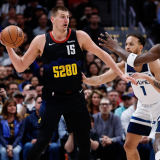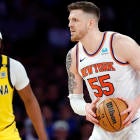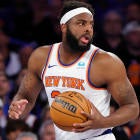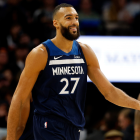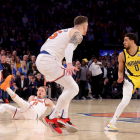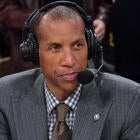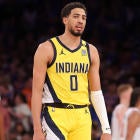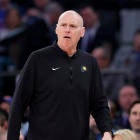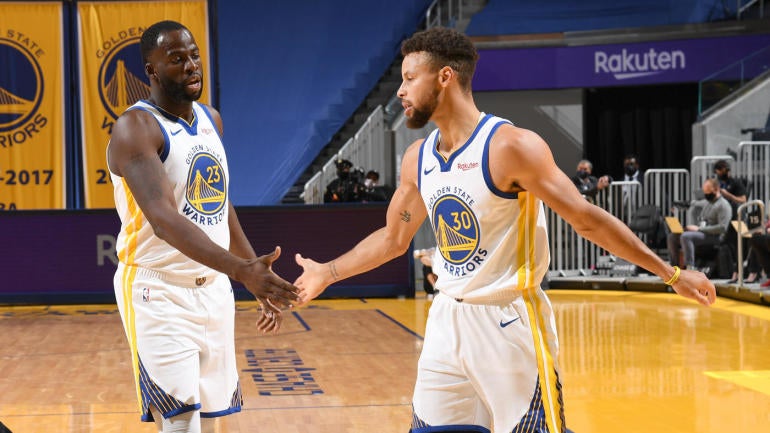
Through the first five games of the season, it was hard to overstate how bad the Golden State Warriors looked. They were the 30th-ranked offense and 29th-ranked defense. Against the three playoff-contending teams they faced, they lost by a combined 90 points. Stephen Curry, by his standards, was struggling, streak-shooting his way to a 32 percent clip from deep and scoring a decent portion of his 26 points per game during the formality minutes of blowouts.
This, of course, initiated a lot of chatter. The Warriors were finished. Curry can't carry a team. The latter is a twisted narrative when you start evaluating Curry's legacy, which is already cemented as indisputably one of the top 20 players of all time, and arguably one of the top 10, no matter what he or the Warriors do from here. None of this is about what Curry has done to this point. If you're trying to argue that, you're dumb.
The only logical talking point centers on Curry moving forward, and whether can still be the kamikaze-shot-making magician he was in the pre-Kevin Durant days. He was, after all, 26 years old at the start of his first MVP season. He's 32 now. One could at least argue that a slight decline happened over that span, only it was undetectable inside an all-time system, next to an all-time teammate.
On Sunday, Curry proved he still has all the goods to go nuclear, hanging a career-high 62 points on Damian Lillard and the Portland Trail Blazers. There were a lot of reasons Curry, who on Monday was named the Western Conference Player of the Week, looked like his old self and the Warriors looked like an actual high-functioning NBA basketball team vs. Portland. The best player on the floor attacked all night long, mostly.
Curry didn't waste any time letting the game come to him; he hunted his shot from the jump, attacking downhill, getting to the basket and creating space for his patented off-the-dribble 3s. He shot 31 times. He made 18 free throws. A pretty hard line can be drawn: If Stephen Curry gets up 30-plus shots and get to the free-throw line 10-plus times, the Warriors are going to be a tough team to beat now that Draymond Green is back.
Ah, Draymond.
Five paragraphs in, and I'm just getting to one of the 10 most important players in the league over the last half-decade. It's a fitting tribute. Green tends to come after Curry in Warriors conversations, but his legacy is cemented, too. The Warriors would not have become a dynasty without Green; they might not have won a single title. Casual fans assume Green's impact is limited to defense, but that's not even remotely true.
Green's playmaking and sense of when and where to get Curry the ball has been one of the main keys to unlocking the Golden State attack. Never was this more evident than in his absence to start this season. Warriors coach Steve Kerr notably prefers a movement-based offense that utilizes Curry in a heavy off-ball role, which necessitates capable facilitators to, in fact, get the ball back to Curry once he gives it up.
It's not just about the actual passing. Most of the passes that lead to a clean look for Curry are pretty routine. It's the timing. The feel and anticipation, not only of what Curry is going to do, but what the defense is going to do in reaction to him. Green's feel for all this is on another level. He processes defenses, particularly as it pertains to finding Curry, like a genius, so often one step ahead of a defense that will lose the Curry battle in a nanosecond of relaxation, and he makes decisions quickly enough to seize these minuscule moments of freedom for the most aggressively tracked shooter in NBA history.
The play below illustrates Green's impromptu playmaking perfectly:
Pay no mind to the fact that Curry didn't make the shot. The point is he got the shot, and it was 100 percent because of Green. At this point Curry was approaching a career high in points and Portland was throwing the kitchen sink at him defensively, so it gets tougher to get him open. You have to get creative. Think about how many times Draymond has taken that same pass over the top of a Curry double team and exploited a 4-on-3 downhill situation. It's second nature for him to turn and attack the paint and look for shooters in the corners.
Thing is: The defense knows this, too. Once Curry gives up the ball that far away from the hoop, the assumption is he's out of the play and there's a moment of relaxation. That's all it takes with someone as quick-witted as Green, who freelances out of his standard read and immediately reverses into a dribble-hand-off/ball screen for Steph, who walked into a wide-open look.
That is the kind of chemistry that had been missing through Golden State's first five games, when Curry, via Kevin O'Connor of The Ringer, "touched the ball in the half court 31 times per 36 minutes, a lower rate than any season since Mark Jackson was still the head coach in 2013-14, according to NBA Advanced Stats.
"Even his brother, Seth Curry, averaged more half-court touches (33.2), as did 86 other players," O'Connor continued. "That changed on Sunday, as Curry set season highs in total touches (88), half-court touches (44), and time possessing the ball (6.6 minutes)."
This changed, again, because Curry was more aggressive and Kerr has already seen the light that he has to up Curry's on-ball activity without the same kinds of shooters and playmakers around him. But even when Curry runs pick-and-roll, defenses are still going to do what the Blazers did above and try to trap him out of the play. Even when he's attacking off the dribble they're going to send two and even three defenders at him, because nobody else on the Warriors scares you as a shooter or scorer.
Point is: The ball can't be in his hands all the time, from the start of a possession to the finish. The problem is not Curry giving the ball up; it's getting it back. With Green on board making plays like the one above, the Warriors are in a far better position to get the ball back to Curry rather than have possessions die in the hands of inferior players as Curry is swarmed off ball.
Green is no stranger to how Curry is defended, and he has a Rolodex of instinctive counters accumulated over years of experience that nobody else on the Warriors can mentally tap into, let alone physically execute. And there is no better illustration of this sixth-sense connection between Curry and Green than this impromptu dribble-handoff that only appears routine because of the quick thinking and experience of the tandem running it.







